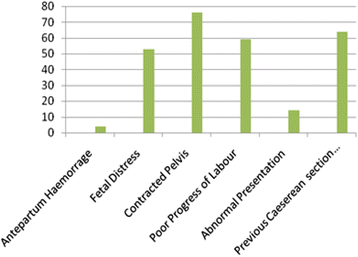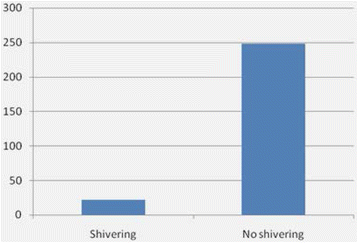Prevalence, associated factors and treatment of post spinal shivering in a Sub-Saharan tertiary hospital: a prospective observational study
- PMID: 27756210
- PMCID: PMC5070127
- DOI: 10.1186/s12871-016-0268-0
Prevalence, associated factors and treatment of post spinal shivering in a Sub-Saharan tertiary hospital: a prospective observational study
Abstract
Background: Surgery and anaesthesia cause shivering due to thermal dysregulation as a compensatory mechanism and is worsened by vasodilatation from spinal anaesthesia that redistributes core body heat. Due to paucity of data Mulago Hospital's post spinal shivering burden is unknown yet it causes discomfort and morbidity.
Methods: Ethical approval was obtained to perform the study among consenting mothers due for elective caesarean section from March to May 2011. We recruited ASA class I & II parturients and excluded non-consenting or spinal contra-indication patients. A standard spinal anaesthetic of 2mls of 0.5 % bupivacaine was given, intraoperative vitals were recorded every 5 min and we monitored for perioperative shivering till PACU discharge.
Results: We recruited 270 patients with majority being emergency caesarean deliveries (90.74 %), mainly due to failed progress from cephalopelvic disproportion. We noted 8.15 % shivering occuring mostly at 20 min, with hypotension plus hypothermia as associated factors. Intravenous pethidine (Meperidine) 25 mg effectively treated shivering and we had drowsiness, nausea and vomiting as PACU side effects that resolved on discharge to the ward.
Conclusion: Post spinal shivering had a prevalence of 8.15 %, commonly occurred at 20 min postoperatively with hypotension plus hypothermia as main associated factors and intravenous Pethidine controlled it.
Keywords: Caesarean section; Pethidine (meperidine); Post spinal shivering; Spinal anaesthesia.
Figures
References
-
- Guyton A. C., Hall J. E. Textbook of Medical Physiology. 11th ed. Philadelphia: Elsevier Inc; 2006. pp. 889–901
-
- Sessler D. I. Temperature monitoring. In: Miller R. D., editor. Miller’s Anesthesia. 6th ed. Philadelphia: Elsevier, Churchill Livingstone; 2005. pp. 1571–1597.
-
- Butterworth JF, Wasnick JD. Morgan & Mikhail’s Clinical Anesthesilogy. 5. New York: McGraw-Hill; 2013. pp. 1184–1185.
Publication types
MeSH terms
Substances
LinkOut - more resources
Full Text Sources
Other Literature Sources
Medical



